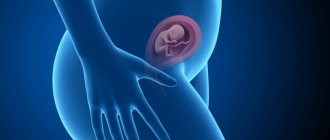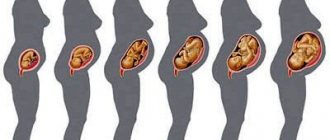Congratulations!! 20 weeks is not just half of your journey with your baby, it is the most difficult and responsible half. Starting this week, your baby’s main task is to grow well. Now he weighs approximately 270 g, and his size is about 15 cm, if measured from the crown to the tailbone and as much as 25 cm - from the heels to the crown. Your baby is approximately the size of a banana. If until half the term we indicated its size without taking into account the length of the legs, now it is already possible to measure the growth of the belly in a standard way, taking into account its entire length.
From 20-22 weeks, the beating of a small heart can already be heard using a regular tube, which the doctor places on your anterior abdominal wall. This week the first stage of the formation of the fetal lungs begins; by the end of the 22nd week the baby will be able to make the first movements with them, which will still be episodic in nature. The intestines and kidneys work well, the gonads function, the spleen functions as a hematopoietic organ. The baby now makes swallowing movements more often, training the digestive system.
By week 20, a black substance called meconium has probably formed in his intestines, which is the result of digestion of amniotic fluid. The baby will continue to produce original feces after birth, so don’t be alarmed if you see a black, sticky substance on the diapers. Occasionally, meconium may pass during labor; its presence in the waste water indicates a not very favorable course of labor.
Interesting Facts
| Options | Indications |
| Time from conception | 18 weeks |
| Period by month | 20 weeks |
| What month | 5 |
| Dimensions and weight of the fetus | 250 mm, 290 g |
| Uterus dimensions | At or above the navel |
| Pregnant weight | The increase over the last week is no more than 400-500 g |
Your baby is the size of
small coconut
250mm Size
290 g Weight
Congratulations! You are exactly halfway there. At week 20, a woman is usually full of strength and joyful, including because she can feel the baby’s movements in the womb. This is the first interaction between mother and child. At this time, you can find out his gender, start choosing a name and planning a dowry for the birth.
Diagnosis of frozen pregnancy
Fading pregnancy can occur at any stage. The cause of this pathology is hormonal disorders, fetal development defects, conflict of Rh factors in the blood of mother and child. If in the early stages of pregnancy it was difficult to immediately diagnose her freezing, then with the appearance of movements the woman herself can sound the alarm. It is important not to confuse pregnancy fading with a decrease in fetal activity during sleep.
Ultrasound and listening to the fetal heartbeat will help confirm or refute the diagnosis. If a tragedy does occur, the woman undergoes removal of the dead fetus and an examination to determine the cause of the miscarriage. Then antibacterial therapy and psychotherapeutic treatment are prescribed. The recovery period can take from 6 months to a year.
Feelings of the expectant mother
By the end of week 20, your weight should normally increase by 3-5 kg. The belly becomes more and more rounded and rises higher. The fundus of the uterus is now at the level of the navel. Every week its size will grow by 1 cm. Due to the growth of the uterus and the pressure it puts on the internal organs, a woman may experience shortness of breath and heartburn.
Abundant mucous vaginal discharge at 20 weeks of pregnancy should not bother you. This is normal, this is how the body protects the fetus from infections. An alarming symptom is bloody or cheesy discharge with an unpleasant odor. The first indicate the threat of interruption, the second indicate the appearance of candidiasis. In both cases, urgent treatment is necessary.
9-12 weeks
At the beginning of pregnancy, the unborn baby is called an embryo, but from the 9th week this term is no longer used. The fetus becomes like a smaller copy of a person; by 11-12 weeks, its heart already has four chambers, and many internal organs are formed. The future baby's limbs and fingers, nose and nostrils, eyes, earlobes are visible. By this time, the expectant mother should have ended toxicosis and feel consistently good, and the feeling of fatigue should also go away.
You can read more about the features of weeks 9-12 here.
How the fetus develops
He has a lot to do now:
- it floats and pushes off the walls of the uterus;
- hiccups;
- flinches if mom is worried;
- thumb sucking;
- swallows amniotic fluid.
The latter contributes to the development of the digestive system. Already now, meconium is forming in the intestines - original feces, which will pass in the first day of the baby’s life.
By the 20th week of pregnancy, the fetus weighs an average of 290 grams, its body length is 16-17 cm from crown to tailbone and 25 cm from head to toe. The active development of the nervous system continues, the senses are improved, and taste buds develop.
The girls have a formed uterus, fallopian tubes and ovaries, in which 7 million eggs have already been formed. In the future, there will be 3.5 times less of them, this is a reserve for the rest of life. In boys, the external genitalia grow, the testicles are still in the abdomen and will descend into the scrotum in the 3rd trimester of pregnancy.
1-4 weeks
The egg grows and matures in the ovary before conception. Ovulation is the movement of a mature egg from the ovary into the fallopian tube. Ovulation occurs in the middle of the cycle. When a mature egg and sperm unite, fertilization occurs, and from this moment the development of the future baby begins.
At week 4, the size of the embryo is only 2-4 mm. As a rule, a woman does not feel anything and often does not even realize that pregnancy is occurring.
You can read more about the first weeks of fetal development here.
Tests and ultrasound
The 20th obstetric week of pregnancy is the last possible for 2 screenings. Go through it if you haven't already. The study will show the possible risks of developing genetic pathologies and structural anomalies of the fetus. The study includes a biochemical blood test and ultrasound.
What will the ultrasound show?
Using ultrasound, the doctor will determine the correspondence of the size of the fetus to the gestational age, assess the amount of amniotic fluid and the condition of the placenta. He will study the structure of internal organs, with special attention paid to the heart and circulatory system.
During an ultrasound at 20 weeks of pregnancy, you will find out the gender of the unborn baby. The risk of error is now minimal, because the fetal genitals are formed. The exception is when the child is “hiding” and there is no way to examine him in detail. In this case, 3D research can help.
If a specialist tells you that the fetus is breech or transverse, do not rush to worry. The most favorable position for childbirth is the head position, which the baby can take even at 38 weeks of pregnancy.
5-8 weeks
The embryo grows, almost a million new cells are formed every minute. By the end of the seventh week, it will already reach one centimeter in length. By the end of the eighth week, the unborn baby will grow to 1.5-2 cm. At this time, primitive nerve pathways begin to form in his brain. During an ultrasound examination with CRT (coccygeal-parietal size) more than four centimeters, the specialist will be able to determine the heartbeat.
You can read more about the features of weeks 5-8 here.
Possible complications
The twentieth week of pregnancy is a relatively calm time for the mother’s health. But even at this stage, pathologies can develop that significantly complicate the course of gestation.
Isthmic-cervical insufficiency
This diagnosis is made if, according to ultrasound data at 16-24 weeks of pregnancy, the length of the cervix is less than 25 mm. This condition is dangerous because it causes miscarriage or premature birth. Occurs as a result of surgical trauma or congenital genetic diseases. For a short cervix, hormonal therapy, wearing a pessary, and suturing are effective.
Placenta previa
Normally, the placenta is usually located along the posterior wall of the uterus or in the fundus, sometimes on the anterior wall. Here she receives better blood supply and is protected from accidental injuries. Previa is said to occur if the placenta is located in the lower parts of the uterus and partially or completely covers the area of the internal os. There is also low placentation, when the placenta does not cover the pharynx, but is located lower than it should be normally.
This complication occurs in only 1% of cases and usually develops against the background of endometrial inflammation after surgery, multiple difficult births, or uterine fibroids.
Late toxicosis, or gestosis
Occurs after 20 weeks of pregnancy. Its symptoms are swelling, increased blood pressure and the presence of protein in the urine. The condition is considered dangerous and requires hospital treatment. To prevent its development, do not miss scheduled appointments with the gynecologist, take a urine test on time, and monitor your blood pressure yourself.
Predisposition factors
The occurrence of twin pregnancy can be facilitated by:
- heredity - the presence of twins in relatives of partners or one of them. More common across generations. Moreover, the relatives may not be close - first cousins or second cousins;
- during pregnancy occurring after 35 years of age - the older the woman giving birth, the higher the chances;
- at the end of taking COCs, the ovaries begin to actively produce hormones, which is why several zygotes can form;
- hormonal stimulation during IVF - more than one artificially grown embryo is transported into the uterus. If two eggs are detected during pregnancy, then one can be removed if desired (resorption);
- history of several births. According to statistics, during the fourth pregnancy, every third woman in labor is diagnosed with multiple births (the so-called parity of pregnancy).
Do's and Don'ts
In addition to the well-known and understandable prohibitions on alcohol and nicotine during pregnancy, we also do not recommend:
- consume more than 300 mg of caffeine per day, that is, about 2 cups, since large doses of caffeine harm the development of the fetus;
- engage in horse riding, tennis, diving, football and other traumatic sports;
- eat thermally unprocessed fish and seafood, eggs and meat, soft blue cheeses, drink unpasteurized milk, as these products sometimes cause parasitic diseases and intestinal infections.
But contrary to stereotypes, during pregnancy you can eat chocolate and citrus fruits, dye your hair, and, in the absence of contraindications, fly on an airplane and have sex.
Dietary recommendations
This part of a pregnant woman’s lifestyle is extremely important for the formation and development of the fetus. It is important to provide the child with the material to grow without gaining excess weight. Therefore, when forming a diet, you should follow the doctor’s recommendations. Most likely, he will advise building a menu primarily on light protein products, including lean meat and fish, dairy products, herbs, fruits and vegetables.
Marinades and pickles, smoked meats and fatty semi-finished products, and canned food are excluded from the expectant mother's diet. The consumption of alcohol, products with dyes and preservatives, and factory-made carbonated drinks is completely excluded.
To optimize the drinking regime, use weak tea with milk, berry fruit drinks, compote of fresh fruits and dried fruits, and clean water. A daily intake of at least 2 liters of fluid per day will help provide all the body’s needs. There is no need to be afraid that such a drinking regime will provoke swelling. Excessive salt intake is responsible for their appearance and increased blood pressure.
Salt negatively affects the condition of the walls of blood vessels and contributes to the concentration of excess fluid in the body, so the presence of salt in food should be limited. If you become overweight, you need to reconsider your diet, include more plant fiber and fewer simple carbohydrates. But complex carbohydrates will only bring benefits to a pregnant woman. They are obtained from bran bread, cereals, and legumes.
The main method of cooking is boiling, steaming, baking. Fried and smoked foods provoke heartburn and excess weight.
Checklist for 20 weeks of pregnancy
- Update your wardrobe: your belly quickly increases in size in the second trimester.
- Continue to lead an active lifestyle: this will help you cope more easily with all the hardships of pregnancy and prepare for childbirth.
- If colostrum appears, you should stock up on absorbent breast wipes.
You can undergo all types of ultrasound during pregnancy, including 3D or with Doppler, at the Women's Medical Center. We have the most modern equipment with highly sensitive sensors. Our specialists have many years of practical experience, which means that the likelihood of errors during the study is excluded.
33-36 weeks
The 36th week will end for the unborn baby with a weight of 2.4-2.8 kg, his height will be approximately 48 cm. Then the baby’s weight will grow by 200 g every week. Thanks to the layer of fat cells, facial features will become rounded, and the facial muscles are already adapted for sucking. Often, during an ultrasound examination during this period, it is clearly visible how the baby tries to put his fist in his mouth or simply sucks his finger.
You can read more about the features of weeks 33-36 here.
Survey
Pregnancy with twins is confirmed using ultrasound examination already at 5-7 weeks of gestation. Fraternal fruits are usually identified earlier than identical fruits. Doctors should warn the couple that it is extremely rare, but still there is a phenomenon called hidden twin syndrome (ischiopagus) - one more developed embryo absorbs the other. Then, during the following diagnostic procedures, a singleton pregnancy is displayed on the ultrasound monitor screens. Also, with incomplete separation, it is possible for twin organisms to join each other (Siamese twins). Modern diagnostic methods make it possible to establish as accurately as possible the fact of twin pregnancy. But the expectant mother should be aware of the risks associated with such a gestation. Thanks to the Doppler system that studies blood flow, an experienced diagnostician can determine the beating of two hearts at once.
A blood test shows an elevated level of an embryo-specific marker - alpha-fetoprotein (AFP), and a reduced iron concentration. Chorionic gonadotropin is higher during pregnancy with twins, and sharp jumps are observed. If a test system is used to determine pregnancy, then due to the concentrated hCG, the control strip will be richer in color. A medical examination and measurements of the uterine fundus show significant expansion of the uterus, which is not typical for normal pregnancy. An obstetrician-gynecologist can palpate two heads.
Features of obstetrics
In half of the cases, births with twin pregnancies occur prematurely, approximately 3-6 weeks earlier than the expected date. There is no need to worry about this. At this intrauterine age, children are mature, ready for life outside the womb, and adapt normally to the external environment. The average birth date is 35-36 weeks, very rarely mothers reach 38-40 weeks. Pregnant women with twins require early hospitalization, at least 14 days in advance. Children born prematurely require intensive care and professional care. The method of delivery is chosen by the obstetrician depending on the presentation, the amount of amniotic fluid, and possible hypoxia.









